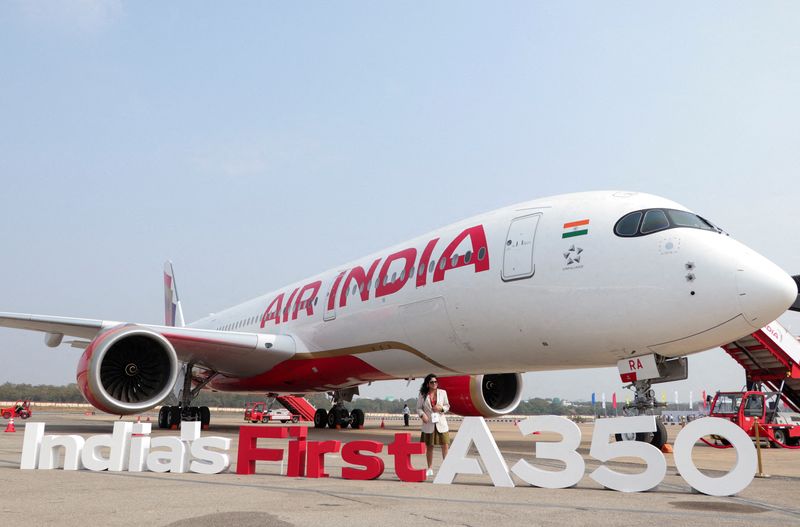Outdated fleet and seats, supply woes hobble Air India’s turnaround
2024.09.26 21:36
By Aditi Shah and Jamie Freed
NEW DELHI/SYDNEY (Reuters) – Two years after Tata Group took control of Air India in a $2.4 billion deal, re-kitting an ageing fleet amid parts shortages and persistent flight delays stand in the way of the former state-owned carrier’s intent to become “a world class airline”.
Global shortages are hurting plans for most airlines, but the problem is “more acute” for Air India, CEO Campbell Wilson said, as India’s flag carrier is nearing the halfway mark of a five-year turnaround plan but starting a generation behind rivals like Dubai’s Emirates and Qatar Airways.
“Our product is obviously a lot more dated. These aircraft haven’t had a product refresh since they were delivered in sort of 2010, 2011. And so it’s more of an acute need for us,” CEO Wilson said in an interview in Sydney.
“If we’ve got legacy seats and legacy in-flight entertainment systems, we’re operating with one arm tied behind our back,” he said.
The challenges are the biggest at the premium end of the plane as Air India looks to lure high-spending travellers, added Wilson, a former Singapore Airlines (OTC:) executive.
Air India has already placed mammoth orders to upgrade its fleet and just this month kicked off a $400 million plan to refit old planes to drive its transformation.
The carrier’s restructuring after decades of decay under state ownership is being watched by manufacturers and lessors, as well as investors in Singapore Airlines – which is set to own a 25% stake in the Indian carrier from November and has agreed to invest an additional up to $600 million in the turnaround.
“Air India … has a long way to go before being closer to international standards for which it needs to complete the process of re-kitting with new and retrofitted aircraft,” Singapore-based independent aviation analyst Brendan Sobie said.
NEED FOR SEATS
Rebuilding Air India’s reputation hinges on getting planes with top-notch premium seats and service in the skies as fast as possible to lure flyers who are reluctant to book the carrier, even if it offers non-stop flights on key international routes, due to poor product and risk of delays.
Of the 470 new planes the airline has ordered, 70 are widebody jets. It has already taken delivery of six Airbus A350s and leased 11 Boeing (NYSE:) 777s.
It is refitting about 67 planes starting with 27 narrowbody ones that will be completed by mid-2025, allowing it to better compete with domestic rival IndiGo’s larger and more modern fleet.
The start of the 40 widebody refits, originally slated for this year, has been pushed to early 2025 due to delays in getting its customised business and first class seats.
Seat manufacturers have said they are grappling with a shortage of skilled labour and capacity, Wilson said.
Once the refit starts, it will take about two years to bring the widebody fleet to international standards, he added.
Older jets have led to lower utilisation by about an hour per day on average across Air India’s fleet, and even more for planes flying long-haul routes like to the U.S., Wilson said.
As an interim solution, Air India is ring-fencing some of its most profitable long-haul sectors like Mumbai to San Francisco and Delhi to London by guaranteeing modern planes.
In the year ended March, Air India increased its capacity by 21% from a year ago and pushed up passenger load factors, or the percentage of seats filled, narrowing net losses by 60% to $532 million and growing its revenues by 24.5% to $6.15 billion.
“When we can command the prices the product deserves and people have a good view of the reliability and service proposition, we can fly to more high-yield routes and bring back the high-yield customer,” Wilson said.
He did not give a target date for reaching profitability.
‘STABILISE THE SHIP’
Air India, founded in 1932 by Tata Group’s late chairman JRD Tata, was once among the world’s best airlines. Since its nationalisation in 1953, it entered a long decline mainly due to lack of investment.
When Tata regained control in 2022, the airline’s systems were antiquated, offices scattered and there were 30 aircraft on the ground for want of spare parts.
“It was just in absolute shambles. We’ve had to really spend the first six months to stabilise the ship,” Wilson said.
By Oct. 1, Air India will have completed the merger of its low-cost carriers Air India Express and AirAsia India, and by Nov. 12 it will add Vistara to the fold, which Tata currently jointly owns with Singapore Airlines.
Flight delays are still an issue, with only 18% of Air India’s flights to Europe and 48% to North America arriving within 15 minutes of the scheduled time in August, according to aviation data provider Cirium.
A shift to Air India’s own maintenance and repair facility should help reduce maintenance-related delays, Wilson said.

The facility, which it is building with help from Singapore Airlines subsidiary SIA Engineering, will be ready by 2026. Air India is contractually obligated to use government-owned Air India Engineering Services Ltd until the end of 2024.
“Two years in, I think we’re in a good place,” Wilson said.








